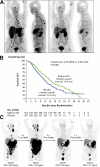α-Emitters for Radiotherapy: From Basic Radiochemistry to Clinical Studies-Part 2
- PMID: 29496984
- PMCID: PMC6910645
- DOI: 10.2967/jnumed.117.204651
α-Emitters for Radiotherapy: From Basic Radiochemistry to Clinical Studies-Part 2
Abstract
The use of radioactive sources to deliver cytotoxic ionizing radiation to disease sites dates back to the early 20th century, with the discovery of radium and its physiologic effects. α-emitters are of particular interest in the field of clinical oncology for radiotherapy applications. The first part of this review explored the basic radiochemistry, high cell-killing potency, and availability of α-emitting radionuclides, together with hurdles such as radiolabeling methods and daughter redistribution. The second part of this review will give an overview of the most promising and current uses of α-emitters in preclinical and clinical studies.
Keywords: clinical trials; radiochemistry; radiotherapy; α-emitters.
© 2018 by the Society of Nuclear Medicine and Molecular Imaging.
Figures




References
-
- Kratochwil C, Bruchertseifer F, Giesel FL, et al. 225Ac-PSMA-617 for PSMA-targeted α-radiation therapy of metastatic castration-resistant prostate cancer. J Nucl Med. 2016;57:1941–1944. - PubMed
-
- Dahle J, Bruland OS, Larsen RH. Relative biologic effects of low-dose-rate alpha-emitting 227Th-rituximab and beta-emitting 90Y-tiuexetan-ibritumomab versus external beam X-radiation. Int J Radiat Oncol Biol Phys. 2008;72:186–192. - PubMed
-
- Heyerdahl H, Krogh C, Borrebaek J, Larsen A, Dahle J. Treatment of HER2-expressing breast cancer and ovarian cancer cells with alpha particle-emitting 227Th-trastuzumab. Int J Radiat Oncol Biol Phys. 2011;79:563–570. - PubMed
Publication types
MeSH terms
LinkOut - more resources
Full Text Sources
Other Literature Sources
